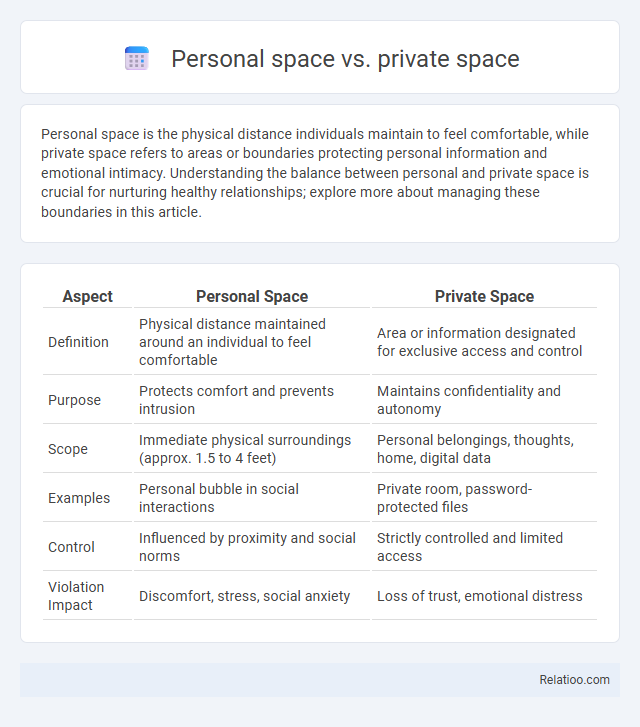Personal space is the physical distance individuals maintain to feel comfortable, while private space refers to areas or boundaries protecting personal information and emotional intimacy. Understanding the balance between personal and private space is crucial for nurturing healthy relationships; explore more about managing these boundaries in this article.
Table of Comparison
| Aspect | Personal Space | Private Space |
|---|---|---|
| Definition | Physical distance maintained around an individual to feel comfortable | Area or information designated for exclusive access and control |
| Purpose | Protects comfort and prevents intrusion | Maintains confidentiality and autonomy |
| Scope | Immediate physical surroundings (approx. 1.5 to 4 feet) | Personal belongings, thoughts, home, digital data |
| Examples | Personal bubble in social interactions | Private room, password-protected files |
| Control | Influenced by proximity and social norms | Strictly controlled and limited access |
| Violation Impact | Discomfort, stress, social anxiety | Loss of trust, emotional distress |
Defining Personal Space and Private Space
Personal space refers to the physical area surrounding an individual that they consider their comfort zone, often measured in inches or feet, and varies based on cultural norms and social context. Private space, on the other hand, is a broader concept encompassing areas such as one's home or personal belongings, where an individual expects privacy and control over access. Understanding the distinctions between personal space and private space is essential for navigating social interactions, respecting boundaries, and maintaining psychological well-being.
Historical Evolution of Personal and Private Spaces
Your understanding of personal space and private space evolves from historical contexts where personal space referred to the immediate physical area individuals maintain around themselves, while private space denoted areas restricted from public access, such as private rooms or homes. Throughout history, cultural shifts and urbanization influenced these concepts, with increased population density reducing personal space and prompting more defined private spaces to safeguard individual autonomy. This historical evolution highlights the dynamic relationship between societal norms, spatial boundaries, and your need for comfort and privacy.
Psychological Importance of Personal Space
Personal space refers to the physical distance individuals maintain to feel comfortable and secure, serving as a buffer against stress and anxiety. Private space, distinct from personal space, denotes areas or possessions reserved exclusively for individual use, crucial for autonomy and self-expression. The psychological importance of personal space lies in its role in regulating social interactions and protecting mental well-being by reducing feelings of vulnerability and promoting a sense of control.
The Role of Private Space in Mental Well-being
Private space serves as a crucial sanctuary for mental well-being by providing a secure environment where you can reflect, recharge, and process emotions away from external pressures. Unlike personal space, which refers to the physical boundary around your body, private space emphasizes control over access and the freedom to engage in intimate thoughts or activities. Maintaining a well-defined private space supports stress reduction, fosters emotional resilience, and enhances overall psychological health.
Cultural Differences in Space Boundaries
Cultural differences significantly influence personal space, private space, and social distance, shaping how individuals perceive and maintain boundaries in various settings. Your comfort with proximity varies across cultures, where some societies prioritize close interpersonal distances while others emphasize larger spatial separations to signal respect or privacy. Understanding these cultural nuances is essential for respectful communication and avoiding discomfort or misunderstandings in multicultural interactions.
Common Violations: Personal vs. Private Space
Common violations of personal space occur when individuals intrude within the typical 18 inches to 4 feet boundary used for casual interactions, causing discomfort or anxiety. Private space violations involve unauthorized entry into areas designated for solitude or confidential activities, such as bedrooms or offices, leading to feelings of vulnerability and breach of trust. Understanding the distinction between personal and private space is essential for respecting boundaries and maintaining healthy social relationships.
Practical Examples in Daily Life
Personal space refers to the physical distance you maintain around yourself to feel comfortable, such as standing an arm's length away during conversations. Private space involves areas or items that you exclusively control or access, like your bedroom or personal diary, ensuring your confidentiality. Social space, larger than personal space, includes settings like office cubicles or classrooms where interactions occur within accepted bounds without invasion of privacy.
Navigating Personal and Private Space in Relationships
Navigating personal and private space in relationships requires clear communication and mutual respect to balance boundaries effectively. Personal space refers to the physical distance individuals maintain for comfort, while private space involves emotional or psychological areas requiring confidentiality and trust. Understanding these distinctions helps partners foster intimacy without compromising autonomy, ensuring healthy and supportive interactions.
Setting and Respecting Space Boundaries
Personal space refers to the immediate physical area surrounding an individual, typically extending about 18 inches to 4 feet, and is crucial for comfort during social interactions. Private space is a more controlled, often enclosed environment like a bedroom or office, where access is limited and personal belongings are safeguarded. Setting and respecting space boundaries involves recognizing cultural norms, individual preferences, and context to maintain trust, prevent discomfort, and promote positive interpersonal relationships.
The Future of Personal and Private Spaces in a Digital World
The future of personal and private spaces in a digital world hinges on evolving technologies like virtual reality, augmented reality, and advanced encryption that redefine boundaries of physical and digital interaction. Personal space, traditionally a physical concept related to proximity and comfort zones, increasingly overlaps with private space, which encompasses sensitive information and digital identities secure from unauthorized access. As remote work, online communities, and interconnected devices proliferate, innovative privacy tools and personalized environments will become crucial for maintaining autonomy and safety in hybrid physical-digital realms.

Infographic: Personal space vs Private space
 relatioo.com
relatioo.com